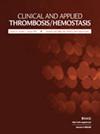用于预测急性缺血性卒中患者溶栓后出血转化的高级机器学习模型:系统回顾和元分析
IF 2.3
4区 医学
Q2 HEMATOLOGY
引用次数: 0
摘要
背景:溶栓治疗是急性缺血性卒中(AIS)治疗的关键,但存在出血转化(HT)的风险,因此需要准确预测以优化患者护理。方法:在 PubMed、Web of Science、Scopus、Embase 和 Google Scholar 上进行了全面检索,涵盖了从开始到 2024 年 7 月 10 日的研究。使用机器学习 (ML) 或深度学习算法预测接受溶栓治疗的 AIS 患者 HT 的研究均被纳入。排除标准包括涉及血管内治疗的研究和未评估模型有效性的研究。数据提取和质量评估遵循 PRISMA 指南,并使用 "个体预后或诊断多变量预测模型透明报告"(TRIPOD)和 "预测模型偏倚风险评估工具"(PROBAST)工具进行。结果:在已确认的 1943 份记录中,有 12 项研究被纳入最终分析,包括 18 007 名接受溶栓治疗的 AIS 患者。ML 模型显示出较高的预测性能,其曲线下面积 (AUC) 值从 0.79 到 0.95 不等。其中,XGBoost 模型的 AUC 值高达 0.953,人工神经网络 (ANN) 模型的 AUC 值高达 0.942。灵敏度和特异性差异显著,灵敏度最高为 0.90,特异性最高为 0.99。高血压的重要预测因素包括年龄、血糖水平、美国国立卫生研究院卒中量表(NIHSS)评分、收缩压和舒张压以及放射学特征。尽管这些结果很有希望,但方法上的差异和有限的外部验证凸显了标准化报告和进一步严格测试的必要性。结论ML技术,尤其是XGBoost和ANN,在预测AIS患者溶栓后的高血压、加强风险分层和临床决策方面大有可为。未来的研究应侧重于前瞻性研究设计、标准化报告以及将 ML 评估纳入临床工作流程,以改善 AIS 管理和患者预后。本文章由计算机程序翻译,如有差异,请以英文原文为准。
Advanced Machine Learning Models for Predicting Post-Thrombolysis Hemorrhagic Transformation in Acute Ischemic Stroke Patients: A Systematic Review and Meta-Analysis
Background: Thrombolytic therapy is essential for acute ischemic stroke (AIS) management but poses a risk of hemorrhagic transformation (HT), necessitating accurate prediction to optimize patient care. Methods: A comprehensive search was conducted across PubMed, Web of Science, Scopus, Embase, and Google Scholar, covering studies from inception until July 10, 2024. Studies were included if they used machine learning (ML) or deep learning algorithms to predict HT in AIS patients treated with thrombolysis. Exclusion criteria included studies involving endovascular treatments and those not evaluating model effectiveness. Data extraction and quality assessment were performed following PRISMA guidelines and using the Transparent Reporting of a Multivariable Prediction Model for Individual Prognosis or Diagnosis (TRIPOD) and Prediction Model Risk of Bias Assessment Tool (PROBAST) tools. Results: Out of 1943 identified records, 12 studies were included in the final analysis, encompassing 18 007 AIS patients who received thrombolytic therapy. The ML models demonstrated high predictive performance, with pooled area under the curve (AUC) values ranging from 0.79 to 0.95. Specifically, XGBoost models achieved AUCs of up to 0.953 and Artificial Neural Network (ANN) models reached up to 0.942. Sensitivity and specificity varied significantly, with the highest sensitivity at 0.90 and specificity at 0.99. Significant predictors of HT included age, glucose levels, NIH Stroke Scale (NIHSS) score, systolic and diastolic blood pressure, and radiomic features. Despite these promising results, methodological disparities and limited external validation highlighted the need for standardized reporting and further rigorous testing. Conclusion: ML techniques, especially XGBoost and ANN, show great promise in predicting HT following thrombolysis in AIS patients, enhancing risk stratification and clinical decision-making. Future research should focus on prospective study designs, standardized reporting, and integrating ML assessments into clinical workflows to improve AIS management and patient outcomes.
求助全文
通过发布文献求助,成功后即可免费获取论文全文。
去求助
来源期刊
CiteScore
4.40
自引率
3.40%
发文量
150
审稿时长
2 months
期刊介绍:
CATH is a peer-reviewed bi-monthly journal that addresses the practical clinical and laboratory issues involved in managing bleeding and clotting disorders, especially those related to thrombosis, hemostasis, and vascular disorders. CATH covers clinical trials, studies on etiology, pathophysiology, diagnosis and treatment of thrombohemorrhagic disorders.

 求助内容:
求助内容: 应助结果提醒方式:
应助结果提醒方式:


